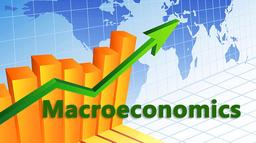
Unit 3 Macroeconomics Review
Quiz by Georgia Powell
Feel free to use or edit a copy
includes Teacher and Student dashboards
Measure skillsfrom any curriculum
Measure skills
from any curriculum
Tag the questions with any skills you have. Your dashboard will track each student's mastery of each skill.
With a free account, teachers can
- edit the questions
- save a copy for later
- start a class game
- automatically assign follow-up activities based on students’ scores
- assign as homework
- share a link with colleagues
- print as a bubble sheet
22 questions
Show answers
- Q1Which of the following describes the goals of macroeconomics?Steady economic growth, stable prices and full employmentStable prices, steady economic growth & lower taxesSteady economic growth, lower taxes and reduction of trade deficitsStable prices, full employment & reduction of trade deficits30s
- Q2Gross domestic product is a method for calculating how much a country produces by adding which four spending categories?Wages, rent, interest & profitConsumption, investment, government and net exportsConsumption, Investment, Government & Business ExpendituresConsumption, interest rates, government & net exports30s
- Q3What is inflation?A rise in the price levelNo changes in the price levelA decrease in the price levelFluctuations in the price level30s
- Q4Comparing real GDP between two consecutive years is MOST useful in determining which economic measurement?Economic growthEquilibrium priceEquityExchange rates30s
- Q5In an economy, when the price level falls, consumers and firms buy more goods and services. How is this relationship represented?Aggregate demand curveBusiness cycleAggregate supply curveEquilibrium GDP30s
- Q6What economic term refers to the percentage of people who want to work, but are unable to find employment?Work rateEmployment rateUnemployment rateInflation rate30s
- Q7Concern about an international crisis has caused consumers to save their money and postpone big purchases. What is the immediate effect on aggregate demand, price level and aggregate supply?Aggregate demand will decrease, price level decreases and unemployment decreasesAggregate demand will decrease, lowering both real GDP and price levelAggregate supply will decrease, raising the price level and lowering real GDPAggregate supply will increase, prices will decrease and real GDP will increase30s
- Q8What is the purpose of the market basket?To compare prices of goods between competing storesTo compare prices of goods between years to calculate the consumer price indexTo determine gross domestic productTo advertise new products for companies30s
- Q9What happens to people living on a fixed income when there is rapid inflation in a country?They must get second jobs to make ends meetThey benefit because their paycheck buys more goods & servicesThey aren't affectedThey're purchasing power is decreased and therefore they're hurt30s
- Q10Which situation below is MOST negatively affected by unanticipated inflation?Farmers with fixed rate mortgatesConvenience stores that sell staple goodsBanks that loaned money at a fixed rateBusinesses that profit from credit sales30s
- Q11In January, Bob is laid off from his job during a business cycle contraction. Which statement is TRUE?Bob is cyclically unemployedBob is frictionally unemployedBob is structurally unemployedBob is seasonally unemployed30s
- Q12Which person is considered frictionally unemployed?Jennifer, whose skills are no longer neededJimmy whose parents shut down the family farmJake who has recently entered the labor forceJill who is a full time college student30s
- Q13In the business cycle, what is a contraction or a recesssion?Increase of productiviyIncrease of moneyBusiness growthSlowing down of business30s
- Q14What is the best description of a trough in the business cycle?People losing jobs, businesses closingLowest point in the economyTop of the expansionNew jobs opening up, economy improving30s
- Q15What is the primary role of money in the economy?It provides a mechanism to assist foreign tradeIt helps set interest rates at financial institutionsIt serves as a medium of exchange for goods & servicesIt identifies prices in various markets.30s